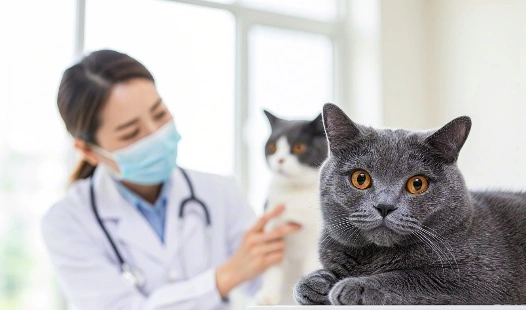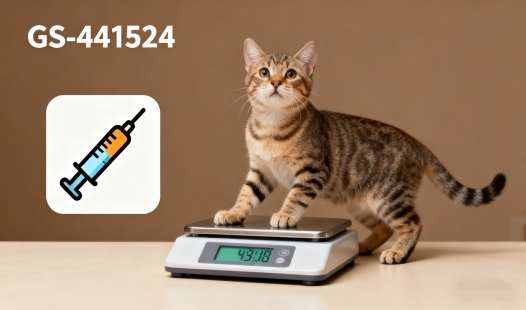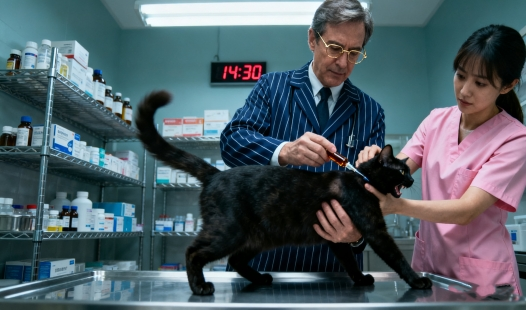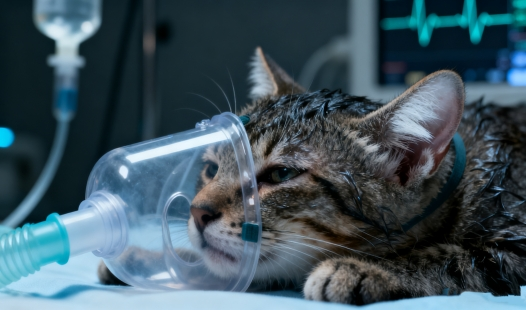Is GS-441524 safe for long-term use in cats?
Preclinical and Clinical Data on Extended GS-441524 Administration
- Preclinical and Clinical Data on Extended GS-441524 Administration
- Monitoring Protocols for Long-Term GS-441524 Use in Feline Patients
- Potential Cumulative Effects and Organ System Considerations with Prolonged GS-441524 Therapy
- Risk-Benefit Analysis of Long-Term GS-441524 Treatment for Chronic FIP Management
- Establishing Safety Parameters for the Duration of GS-441524 Therapy
- Conclusion
- FAQ
- Partner with BLOOM TECH for High-Quality GS-441524
- References
GS-441524 FIP has shown promise as a way to treat feline infectious peritonitis (FIP), a disease that cats used to die from. As more vets and cat owners think about giving this medicine to their cats for a long time, concerns about its safety over the long run arise. This detailed article looks at the latest research on GS-441524's safety when given for a long time to cats.


Preclinical and Clinical Data on Extended GS-441524 Administration
Understanding the safety of GS-441524 for long-term use requires examining both preclinical studies and clinical experiences. While research is ongoing, initial findings provide valuable insights into the medication's extended-use safety profile.
Preclinical Studies
Preclinical studies on GS-441524 and its parent compound, remdesivir, have shown promising results regarding long-term safety. Animal models, including cats, have demonstrated that the drug is generally well-tolerated when administered over extended periods. These studies have evaluated various physiological parameters, including liver and kidney function, to assess potential toxicity.
Clinical Observations
Clinical experiences with GS-441524 in cats with FIP have been largely positive. Veterinarians treating cats with the medication have reported minimal adverse effects, even with prolonged use. Many cats have received the treatment for 12 weeks or longer without significant complications. However, it's important to note that formal long-term safety studies in large feline populations are still limited.
Comparative Data
Comparing GS-441524 to other antiviral medications used in veterinary medicine can provide additional context for its safety profile. While each drug has unique characteristics, the product has shown a favorable safety profile relative to some other antivirals used for extended periods in cats.
Monitoring Protocols for Long-Term GS-441524 Use in Feline Patients
To ensure the safe long-term use of GS-441524 in cats, veterinarians have developed comprehensive monitoring protocols. These protocols aim to detect any potential adverse effects early and adjust treatment as needed.
Regular Physical Examinations
Cats receiving long-term GS-441524 therapy should undergo regular physical examinations. These check-ups allow veterinarians to assess the cat's overall health, monitor for any clinical signs of toxicity, and evaluate the response to treatment. The frequency of examinations may vary based on the individual cat's condition and treatment duration.
Blood Work and Laboratory Testing
Periodic blood work is crucial for monitoring organ function and detecting any subclinical issues. Common tests include:
- Complete blood count (CBC) to assess overall health and immune function
- Serum chemistry panel to evaluate liver and kidney function
- Electrolyte levels to ensure proper balance
- Specific FIP-related markers, such as albumin-to-globulin ratio
Imaging Studies
In some cases, veterinarians may recommend periodic imaging studies, such as ultrasounds or radiographs, to monitor internal organs and assess for any structural changes that could indicate toxicity or disease progression.
 |
 |
 |
Potential Cumulative Effects and Organ System Considerations with Prolonged GS-441524 Therapy
Prolonged usage of GS-441524 may potentially have an effect on a number of organ systems, despite the fact that it has demonstrated a solid safety profile. Understanding these potential consequences is essential for administering the medication in a responsible manner over the long term.
Liver Function
The liver plays a vital role in metabolizing GS-441524. Long-term use may theoretically impact liver function, although significant hepatotoxicity has not been widely reported. Regular monitoring of liver enzymes and function tests is essential to detect any early signs of liver stress.
Kidney Function
With prolonged usage of GS-441524, there is a potential risk of kidney stress, similar to the risk that is associated with many other drugs. Regular monitoring of renal parameters, such as blood urea nitrogen (BUN) and creatinine levels, is an effective method for ensuring that kidney function remains consistent during the course of treatment.
Hematopoietic System
The generation of blood cells can be influenced by certain antivirals. Although there is no evidence that GS-441524 is significantly harmful to the hematological system, performing complete blood counts on a regular basis can assist in identifying any potential effects on the bone marrow or blood cell populations.
Risk-Benefit Analysis of Long-Term GS-441524 Treatment for Chronic FIP Management
It is vital to conduct a comprehensive risk-benefit analysis before deciding whether or not to pursue long-term treatment with GS-441524 for the management of chronic FIP. After conducting this analysis, the possible dangers of continued pharmaceutical use are weighed against the advantages of managing an illness that poses a significant risk to one's life.
Potential Benefits
The primary benefit of long-term product treatment is the management of FIP, a disease that was once considered uniformly fatal. Successful treatment can lead to:
- Improved quality of life for affected cats: By addressing the underlying viral infection, the GS-441524 tablet helps alleviate symptoms such as fever, pain, and lethargy. This enables cats to regain energy, appetite, and overall well-being, leading to a more normal and comfortable life.
- Extended survival times: With consistent and effective treatment, cats with FIP can experience a significantly prolonged life. While FIP used to have a poor prognosis, the GS-441524 tablet offers a chance for many cats to live for months or even years after diagnosis, providing a better future for both the pet and their owners.
- Potential for complete remission in some cases: In certain cases, GS-441524 tablet therapy can lead to complete remission of FIP. This means that the virus is fully suppressed, and the cat may show no further symptoms or signs of the disease, offering a hopeful outcome for pet owners who once feared the worst.
Potential Risks
While GS-441524 has shown a favorable safety profile, potential risks of long-term use may include:
- Organ system stress, particularly on the liver and kidneys
- Possible development of drug resistance
- Financial burden of prolonged treatment
Individualized Assessment
The decision to pursue long-term GS-441524 treatment should be made on a case-by-case basis. Factors to consider include:
- The cat's overall health status
- The severity and progression of FIP
- The cat's response to initial treatment
- The owner's ability to comply with treatment protocols and monitoring
Establishing Safety Parameters for the Duration of GS-441524 Therapy
To ensure the safe long-term use of fip medication like GS-441524, establishing clear safety parameters is crucial. These guidelines help veterinarians and cat owners make informed decisions about continuing or adjusting treatment.
Treatment Duration Guidelines
While the optimal duration of GS-441524 therapy can vary, some general guidelines have emerged:
- Initial treatment course: Typically 12 weeks
- Extended treatment: May be considered for cats with persistent or recurrent disease
- Maintenance therapy: Some cats may benefit from longer-term, lower-dose maintenance treatment
Safety Thresholds
Establishing safety thresholds for various physiological parameters helps guide treatment decisions. These may include:
- Upper limits for liver enzyme elevations: It's important to monitor liver enzymes during treatment, as excessive elevations could indicate liver stress or damage. Setting upper limits allows veterinarians to track these changes and intervene before serious liver complications occur.
- Acceptable ranges for kidney function markers: Monitoring kidney function is crucial to ensure that treatment does not negatively impact the kidneys. Establishing acceptable ranges for markers like creatinine and BUN helps detect early signs of renal impairment, allowing for adjustments in dosage or therapy duration.
- Minimum blood cell count thresholds: Blood cell counts, particularly red and white blood cells, are vital indicators of overall health. Setting minimum thresholds ensures that the treatment does not cause harmful drops in blood cell levels, which could lead to anemia or weakened immune response, both of which would require immediate attention.
Dose Adjustment Protocols
Developing protocols for dose adjustments based on monitoring results can help optimize safety. This may involve:
- Gradual dose reductions for cats responding well to treatment
- Temporary treatment interruptions if safety thresholds are exceeded
- Adjunctive therapies to support organ function if needed
|
|
|
Conclusion
Current evidence suggests that GS-441524 can be safe for long-term use in cats when administered under proper veterinary supervision. While the medication has shown a favorable safety profile, ongoing monitoring and individualized assessment are crucial to ensure the best outcomes for feline patients with FIP. As research continues, our understanding of GS-441524's long-term safety will undoubtedly evolve, potentially opening new avenues for chronic FIP management.
FAQ
1. How long can a cat safely take GS-441524?
The safe duration of GS-441524 treatment can vary depending on the individual cat's response and health status. Many cats have been treated for 12 weeks or longer without significant adverse effects. However, the optimal duration should be determined by a veterinarian based on regular monitoring and assessment.
2. Are there any long-term side effects of GS-441524 in cats?
While long-term studies are still limited, current evidence suggests that GS-441524 is generally well-tolerated. Potential long-term effects may include impacts on liver or kidney function, but these are typically monitored through regular check-ups and blood work. Severe long-term side effects have not been widely reported with proper use and monitoring.
3. Can GS-441524 be used as a maintenance therapy for FIP?
Some veterinarians have explored using GS-441524 as a maintenance therapy for cats with chronic or recurrent FIP. This approach typically involves lower doses over extended periods. However, the efficacy and safety of long-term maintenance therapy are still being studied, and decisions should be made on a case-by-case basis in consultation with a veterinarian.
Partner with BLOOM TECH for High-Quality GS-441524
As one of the biggest GS-441524 manufacturer companies, BLOOM TECH is dedicated to giving vets the best FIP medicine for their kitty patients. Our GMP-certified production sites and strict quality control measures make sure that the purity and potency of our products are always the same. You can be sure that the long-term FIP treatments you offer to cat owners are safe and successful if you buy from BLOOM TECH. As a leading GS-441524 manufacturer, we are committed to maintaining the highest standards in production to ensure consistent results. Our skilled staff is ready to help your business by giving you accurate information about our products and quick responses to your questions. For inquiries about our GS-441524 products or to discuss your specific needs, please contact us at Sales@bloomtechz.com. Choose BLOOM TECH for reliable, high-quality GS-441524 products to advance your feline FIP treatment protocols.
References
1. Pedersen, N.C., et al. (2019). Efficacy and safety of the nucleoside analog GS-441524 for treatment of cats with naturally occurring feline infectious peritonitis. Journal of Feline Medicine and Surgery, 21(4), 271-281.
2. Murphy, B.G., et al. (2020). Treatment of cats with feline infectious peritonitis with the nucleoside analog GS-441524. Animals, 10(2), 289.
3. Dickinson, P.J., et al. (2020). Antiviral treatment using the adenosine nucleoside analogue GS-441524 in cats with clinically diagnosed neurological feline infectious peritonitis. Journal of Veterinary Internal Medicine, 34(4), 1587-1593.
4. Addie, D.D., et al. (2020). Feline infectious peritonitis. ABCD guidelines on prevention and management. Journal of Feline Medicine and Surgery, 22(11), 1047-1068.

Echo
9 years of experience in chemical articles; Doctoral degree; Organic Chemistry major; R&D-4 Dept; Technology support; R&D engineer
Anticipating your Business & Technology support inquiry
Please send us the products that interest you, and we will provide you with one-on-one service
Recommended Blog

How to Choose a GS-441524 Brand and Supplier: 5 Key Factors to Consider

What are the different administration methods for GS-441524?

Emotional support for pet owners during FIP treatment journey

What should cats eat during GS 441524 treatment for faster recovery?
_副本_1761184166100.webp)
Understanding FIPV in Multi-Cat Households: Risks and Prevention





_副本_1761272616887.webp)

_副本_1758248142309.webp)

